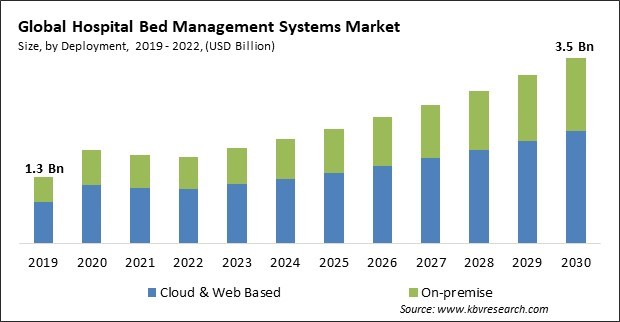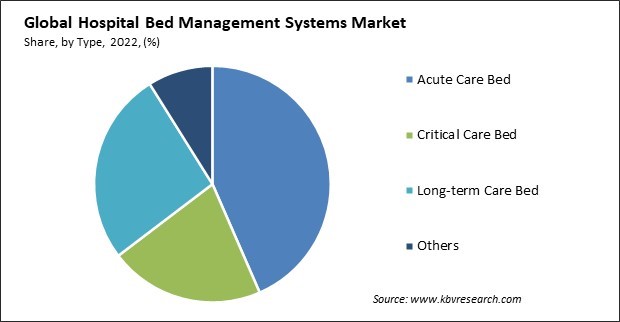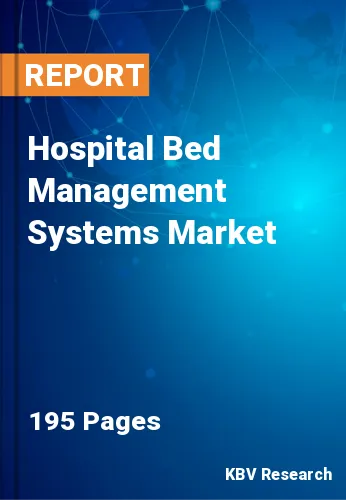The Global Hospital Bed Management Systems Market size is expected to reach $3.5 billion by 2030, rising at a market growth of 10.0% CAGR during the forecast period.
With large and diverse populations in many countries across the Asia Pacific, HBMS helps healthcare facilities manage patient populations efficiently. Therefore, Asia Pacific segment would capture 1/4th share of the market by 2030. As a result, with the integration of telehealth, HBMS assists in providing healthcare services to remote locations in the Asia-Pacific region where access to healthcare facilities may be limited. Some of the factors impacting the market are technological advancements and integration, increasing prevalence of chronic diseases and resource constraints and budgetary concerns.

Continuous advancements in healthcare technology, including data analytics, artificial intelligence, and interoperability, contribute to the growth of the HBMS. Integrating these technologies into bed management systems enhances their capabilities, allowing for real-time data analysis, predictive modeling, and seamless connectivity with other healthcare IT systems. The integration of artificial intelligence into bed management systems is transforming decision-making processes. Additionally, the increasing prevalence of chronic diseases globally strains healthcare systems, requiring better patient admissions and ongoing care management. Hospital bed management systems help healthcare providers handle the complexities associated with chronic conditions by optimizing bed allocation, ensuring continuity of care, and improving overall patient outcomes. Chronic diseases, including cardiovascular diseases, diabetes, respiratory conditions, and cancer, are on the rise globally. Therefore, the market is expanding significantly due to the technological advancements and integration and as a result of the increasing prevalence of chronic diseases.
Additionally, the strain on healthcare systems revealed the vulnerabilities in traditional bed management processes. As hospitals faced bed shortages due to the influx of COVID-19 patients, there was a rapid acceleration in the adoption of these systems. These systems played a pivotal role in optimizing existing resources, ensuring that beds were allocated based on urgency and severity of cases. Hospital bed management systems are considered integral components of digitally resilient healthcare infrastructure, prompting ongoing technological investments to ensure preparedness for future public health crises. These technologies became instrumental in forecasting patient admissions, optimizing resource allocation, and facilitating informed decision-making amidst the uncertainties of the pandemic. Thus, the COVID-19 pandemic had a moderate effect on the market.
However, Insufficient financial resources can compromise the implementation and maintenance of hospital bed management systems. Limited budgets may result in the selection of lower-cost, less robust solutions, leading to suboptimal system performance and reduced functionality. Additionally, ongoing maintenance and updates may be neglected, affecting the long-term effectiveness of the systems. Resource constraints and budgetary concerns is a significant challenge that hampers the growth of market.
By type, the market is categorized into acute care bed, critical care bed, long-term care bed, and others. In 2022, the acute care bed segment held the highest revenue share in the market. Hospital bed management systems are designed to optimize the allocation of acute care beds based on patient acuity, medical needs, and bed availability. These systems use real-time data to match the severity of patient conditions with the appropriate level of care, ensuring efficient bed utilization and reducing wait times. Acute care beds are often in high demand due to the urgent nature of conditions requiring this level of care. Hospital bed management systems streamline the admission process by providing quick access to real-time bed availability data, allowing healthcare providers to admit patients promptly and initiate necessary treatments without delays.

Based on deployment, the market is classified into cloud & web based and on-premise. The on-premise segment acquired a substantial revenue share in the market in 2022. Healthcare facilities often prioritize maintaining control over sensitive patient data. On-premises solutions provide higher control and security as data is stored within the facility's local servers. This can particularly appeal to organizations with strict data governance requirements and data privacy and compliance concerns. Healthcare facilities with established on-premises infrastructure, including EHR, laboratory information systems, and other in-house solutions, may prefer on-premises bed management systems for seamless integration. This approach enables a cohesive healthcare IT environment, avoiding potential compatibility issues with existing systems.
| Report Attribute | Details |
|---|---|
| Market size value in 2022 | USD 1.7 Billion |
| Market size forecast in 2030 | USD 3.5 Billion |
| Base Year | 2022 |
| Historical Period | 2019 to 2021 |
| Forecast Period | 2023 to 2030 |
| Revenue Growth Rate | CAGR of 10% from 2023 to 2030 |
| Number of Pages | 195 |
| Number of Table | 260 |
| Report coverage | Market Trends, Revenue Estimation and Forecast, Segmentation Analysis, Regional and Country Breakdown, Porter’s 5 Forces Analysis, Company Profiling, Companies Strategic Developments, SWOT Analysis, Winning Imperatives |
| Segments covered | Type, Deployment, Region |
| Country scope |
|
| Companies Included | Oracle Corporation, Epic Systems Corporation, GE HealthCare Technologies, Inc., HealthStream, Inc., TeleTracking Technologies, Inc., SAP SE, JVS Group, Advanced Data Systems Corporation, NextGen Healthcare, Inc., and McKesson Corporation |
| Growth Drivers |
|
| Restraints |
|
Region-wise, the market is analysed across North America, Europe, Asia Pacific, and LAMEA. In 2022, the North America region led the market by generating the highest revenue share. North America boasts an advanced and well-developed healthcare infrastructure comprising a network of hospitals, clinics, and healthcare facilities. The integration of telehealth capabilities within HBMS is gaining prominence in North America. The interconnected nature of the North American healthcare landscape requires HBMS to be interoperable with various healthcare systems and technologies.
Free Valuable Insights: Global Hospital Bed Management Systems Market size to reach USD 3.5 Billion by 2030
The market research report covers the analysis of key stake holders of the market. Key companies profiled in the report include Oracle Corporation, Epic Systems Corporation, GE HealthCare Technologies, Inc., HealthStream, Inc., TeleTracking Technologies, Inc., SAP SE, JVS Group, Advanced Data Systems Corporation, NextGen Healthcare, Inc., and McKesson Corporation.
By Deployment
By Type
By Geography
This Market size is expected to reach $3.5 billion by 2030.
Technological advancements and integration are driving the Market in coming years, however, Resource constraints and budgetary concerns restraints the growth of the Market.
Oracle Corporation, Epic Systems Corporation, GE HealthCare Technologies, Inc., HealthStream, Inc., TeleTracking Technologies, Inc., SAP SE, JVS Group, Advanced Data Systems Corporation, NextGen Healthcare, Inc., and McKesson Corporation.
The expected CAGR of this Market is 10.0% from 2023 to 2030.
The Cloud & Web Based segment is generating the highest revenue in the Market, by Deployment in 2022; thereby, achieving a market value of $2.1 Billion by 2030.
The North America region dominated the Market, by region in 2022, and would continue to be a dominant market till 2030; thereby, achieving a market value of $1.3 Billion by 2030.
Our team of dedicated experts can provide you with attractive expansion opportunities for your business.

